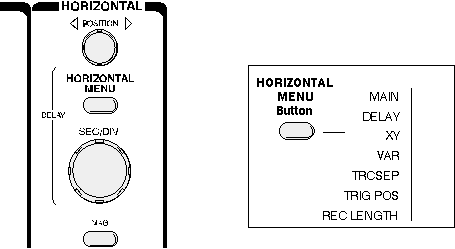|
Use the horizontal controls to position and scale the waveform horizontally. Following figure shows a typical front panel and on-screen menus for the horizontal controls. 
Horizontal Controls
Position and Seconds per Division
The horizontal position control moves the waveform from left and right to exactly where you want it on the screen.
The seconds per division (usually written as sec/div) setting lets you select the rate at which the waveform is drawn across the screen (also known as the time base setting or sweep speed). This setting is a scale factor. For example, if the setting is 1 ms, each horizontal division represents 1 ms and the total screen width represents 10 ms (ten divisions). Changing the sec/div setting lets you look at longer or shorter time intervals of the input signal.
As with the vertical volts/div scale, the horizontal sec/div scale may have variable timing, allowing you to set the horizontal time scale in between the discrete settings.
Time Base Selections
Your oscilloscope has a time base usually referred to as the main time base and it is probably the most useful. Many oscilloscopes have what is called a delayed time base - a time base sweep that starts after a pre-determined time from the start of the main time base sweep. Using a delayed time base sweep allows you to see events more clearly or even see events not visible with just the main time base sweep.
The delayed time base requires the setting of a delay time and possibly the use of delayed trigger modes and other settings not described in this book. Refer to the manual supplied with your oscilloscope for information on how to use these features.
Trigger Position
The trigger position control may be located in the horizontal control section of your oscilloscope. It actually represents "the horizontal position of the trigger in the waveform record." Horizontal trigger position control is only available on digital oscilloscopes.
Varying the horizontal trigger position allows you to capture what a signal did before a trigger event (called pretrigger viewing).
Digital oscilloscopes can provide pretrigger viewing because they constantly process the input signal whether a trigger has been received or not. A steady stream of data flows through the oscilloscope; the trigger merely tells the oscilloscope to save the present data in memory. In contrast, analog oscilloscopes only display the signal after receiving the trigger.
Pretrigger viewing is a valuable troubleshooting aid. For example, if a problem occurs intermittently, you can trigger on the problem, record the events that led up to it and, possibly, find the cause.
Magnification
Your oscilloscope may have special horizontal magnification settings that let you display a magnified section of the waveform on-screen.
XY Mode
Most oscilloscopes have the capability of displaying a second channel signal along the X-axis (instead of time). This is called XY mode. |